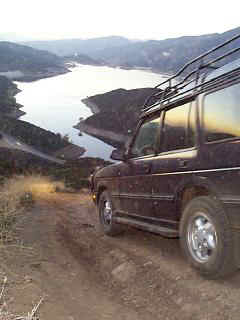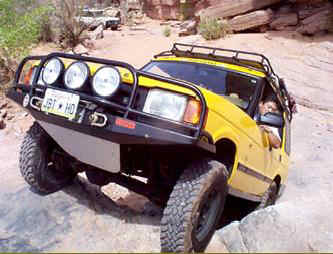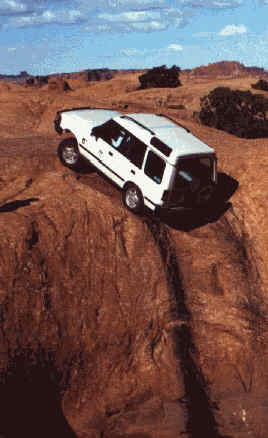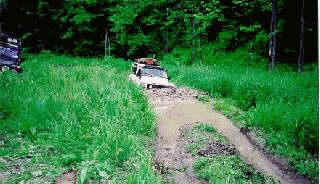|
Roads
can get boring. But what do you do?
You take your car the hell off them, that's what. But don't assume that just because you've shelled out twenty grand on a brand new 4X4 pose-mobile you can throw it up a green lane and power through
(Don't you think, X-Files? - DJ Ess, Nase_2K and Fitchy). It's only 30% car ability, 70% driver ability, which is why you can have a damn good go at tackling
rough terrain in a 2X4 if you know what you're doing. Which I do 
If you just want to pull a trailer full of hay bales off a field, or park in a muddy field for the village fate, then you don't have to worry about preparing. But if you want to go for a serious days off roading, or need to use your 4X4 to pull a heavy object across slippery ground, it helps to make sure of a few things first.

Have a read of your manual, and make sure you know how the four-wheel drive system works. You don't want to be in 2wd when you need 4.
Make sure your car is in vaguely good condition. Don't buy extra's from Dodgy Dave, they could break just when you need them.
Take spare parts with you for anything that could go wrong. The old 'Take a spare Land Rover' joke comes to mind.
Don't go on your own. Take a few mates, and, ideally, more than one 4X4. Have two good tow ropes, and don't forget the most important bit of equipment you can take; a 5x7 foot sheet of plastic. There is so much you can do with one of these; if you have to crawl under the truck in mud, you can lay on it. If you have to wade through a deep river, open the bonnet and place it in front of the grill. Close the bonnet on it and go swimming! The plastic will divert the water around the engine compartment as long as you keep moving. Bust a window out and it's raining - duct tape the plastic over hole. Raining and you have to winch out? Cut a hole big enough for your head and wear it as a coat! 1001 uses! Also take a toolkit, some soap and an egg. Rub the soap onto a small leak
in your fuel line and it will harden to keep the fuel on the inside. Pour egg-white into a radiator which is leaking and the leak will magically seal. Also, don't forget your best friend : Mr Spade.
Try and sort your car out with some decent off-roading
tyres, and, if you are really serious, get a winch.

Right! So, how is it done? Well, let's start off with the stuff you'll encounter most often : Mud.
If it's just a small patch of mud, stop the car and get out to look at it. If it hasn't got a huge deep hole or any other obstacles in it, get back in your car and drive through it as fast as you think is safe, using your momentum to carry you through. Bear in mind, though, that momentum isn't always the most important thing; traction is. It's good to keep up some momentum at all times, so try to avoid stopping in the middle of a swamp, or whatever. Try to keep the car flowing, that is, try to keep a constant pace through the mud, taking as straight a line as possible. Be aware of any obstacles, like rocks, or deep holes, and take a nice early detour around them. Let your tyres down to about 10 psi if it is very muddy, more of them will be on the floor and so more traction will be provided. If there are ruts, try your best to keep out of them - because once in them, it is quite hard to get out. Also, if you are following ruts, always know where your front wheels are pointing. A vehicle will follow ruts no matter which way the wheels are heading, and a sudden dry patch could cause the vehicle to jump violently to the left or the right. If your vehicle drops into a unseen hole, use the momentum you gain going down into it to carry you through. Also, bear in mind that a moving 4x4 has more traction going backwards than it does when going forwards. This might be your only option, but make it your last one. So, you are through the mud. But, Jesus Christ, look at that hill up ahead! Surely you'll have to turn back, right?

Wrong. If there is one thing that surprises people about 4x4's, it's their ability to climb hills. First, before you go up, get out and walk up to the top to check what is on the other side. You don't want to be making a triumphant blast to the top only to find a sheer drop. There are two ways to tackle a hill, depending on what the situation is. If it is wet and muddy, and there isn't much space, then you want to try and get up the hill first time so you don't make it harder for yourselves on the second try. If the hill is firm and dry, then you get as many chances as you want.
Let's, for now, assume the hill is dry. Select a gear that will give you lots of power (low second or low third are good), and drive up the hill at a sensible speed. If you make it, all well and good, and you have plenty of control over the vehicle at the top. If not, you'll have to have another go, and you'll have a better idea of the speed
you need next time. This is where the need for bottle comes in. If your car loses traction on a hill, stall it by putting your foot on the brakes (if it just stalls due to lack of power, jump on the brakes fast anyway). Hopefully, it will stay where it is. If it starts to slide backward... Well, I'll come to that in a minute. So, there you are, stopped halfway up a 60 degree slope. Keeping your foot on the brake, put the car into reverse (make sure you are in low range, fool). Very gently come off the brakes, and the stalled engine should keep you from rolling anywhere (if it doesn't, keep your foot on the brakes just enough to let it trickle backwards slowly). Then, turn around to look behind you, and, keeping your feet off all three pedals, start the engine with the car still in gear. In theory it will slowly trickle backward, engine breaking keeping everything nice and steady. If you think the car is starting to slide, give it a bit of right foot to let the wheels catch up with the ground.

Now, what if the car slides backwards while you are standing
on the brakes
(Panic and crash? - Fitchy)? First, keep calm (or try to, if it's muddy the bastard things don't half rocket off backwards). Do the same as above - keep your foot on the brakes and get the car into reverse (quickly) make sure the ignition is on and let the clutch up at the same time as turning the keys and coming off the brakes. Turning wheels have more traction than sliding ones, so the vehicle should start to feel a little more under control. If it doesn't, then give it some more gas until you feel the car catch up with itself, then gradually come off the throttle to slow it down again. Stop (obviously) at the bottom. Wipe the sweat off your hands, then have another damned good go at the hill! Don't let it beat you! Never, ever, chicken out (unless it's seriously dangerous, of course). So, to recap, take as much speed as you need to get to the top of the hill without mishap, and than carry on driving. Fortunately, going down a hill is much, much easier.
Drive to the edge of the hill, Put it in low-first, clutch up, and let it roll, on tick-over, over the edge and down the hill.
Keep your feet away from everything, and let the engine braking do it all for you. Or, if your car has one of those hill descent buttons, press it and let it drive you.

What do you find a the bottom of a hill? Water! Unguarded, your car should be able to go into water about twenty inches deep. If you are six feet tall, that is about up to your knees. Pathetic, huh? So, get out your sheet of plastic and cover up the rad, or have the entire engine bay water-proofed. With the plastic you can wade up to about 40 inches (up to a six foot man's belt line) as long as you keep moving. You stop, and all the water floods in. Oh, and make sure you put the plastic on the outside. So, how to drive it? Well, first, as always, it's a good idea to check for large rocks or any other obstacles, then dive boldly in, keep a speed good enough to create a bow wave in front of the car (like I'm
above). This will make the water in front more shallow, and make the going easier. Be ready for a quick blast out of the water when you get to the other side. Sorted!
So, mud, water and hills pretty much cover most things you are going to find in the UK. Next month, we'll hit sand, snow and big rocks, and learn what to do when everything goes tit's up. Happy plugging, y'all!
|






